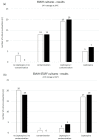Influence of Selective Agents (EMJH-STAFF), Sample Filtration and pH on Leptospira interrogans Serovar Icterohaemorrhagiae Cultivation and Isolation from Swine Urine
- PMID: 34070655
- PMCID: PMC8226611
- DOI: 10.3390/vetsci8060090
Influence of Selective Agents (EMJH-STAFF), Sample Filtration and pH on Leptospira interrogans Serovar Icterohaemorrhagiae Cultivation and Isolation from Swine Urine
Abstract
Leptospira spp. cause the zoonotic disease leptospirosis, which occurs in numerous mammalians worldwide. Isolation is still important for serotyping and genotyping of Leptospira, which in turn is essential for epidemiological surveillance of leptospirosis and the development of diagnostic tests and vaccines. However, isolation of Leptospira from clinical specimens is inherently insensitive. This study was conducted to examine the influence of selective agents, sample filtration, sample pH and the use of phosphate buffered saline (PBS) buffer for sample storage to improve the success of cultivation and isolation of Leptospira interrogans serovar Icterohaemorrhagiae from swine urine. EMJH (Ellinghausen McCullough, Johnson and Harris) medium including the selective agents sulfamethoxazole, trimethoprim, amphotericin, fosfomycin and 5-fluorouracil (STAFF) increased the success of Leptospira isolation from spiked swine urine samples. Sample filtration yielded only negative results. Isolation in EMJH-STAFF was successful from swine urine with a density as low as 104 Leptospira/mL, and urine with pH ≤ 7 impaired the cultivation rate. Cultivation and isolation were not improved by the addition of PBS to spiked urine samples prior to storage for 24 h at 4 °C. The results of the study demonstrate that cultivation and isolation of leptospires from swine urine can be improved by enhanced methods.
Keywords: EMJH-STAFF; Icterohaemorrhagiae; Leptospira; PBS; isolation; pH; swine urine.
Conflict of interest statement
The authors declare no conflict of interest.
Figures






Similar articles
-
Usage of a selective media (EMJH-STAFF) in primary culturing of pathogenic leptospires from bovine clinical samples.Lett Appl Microbiol. 2015 Dec;61(6):603-6. doi: 10.1111/lam.12501. Epub 2015 Nov 2. Lett Appl Microbiol. 2015. PMID: 26408270
-
Leptospiral Culture without 5'-Fluorouracil Revealed Improved Leptospira Isolation from Febrile Patients in North-Eastern Malaysia.Int J Environ Res Public Health. 2020 Feb 18;17(4):1307. doi: 10.3390/ijerph17041307. Int J Environ Res Public Health. 2020. PMID: 32085530 Free PMC article.
-
Improvement of the enrichment used in the EMJH medium (Ellinghausen-McCullough-Johnson-Harris) for the cultivation of Leptospira spp.Rev Argent Microbiol. 2022 Apr-Jun;54(2):95-99. doi: 10.1016/j.ram.2021.03.002. Epub 2021 Jun 1. Rev Argent Microbiol. 2022. PMID: 34083031
-
Shedding and Genetic Diversity of Leptospira spp. From Urban Stray Dogs in Klang Valley, Malaysia.Top Companion Anim Med. 2021 Nov;45:100562. doi: 10.1016/j.tcam.2021.100562. Epub 2021 Jul 13. Top Companion Anim Med. 2021. PMID: 34271178
-
Leptospira and leptospirosis in China.Curr Opin Infect Dis. 2014 Oct;27(5):432-6. doi: 10.1097/QCO.0000000000000097. Curr Opin Infect Dis. 2014. PMID: 25061933 Review.
Cited by
-
Leptospira interrogans Serovar Icterohaemorrhagiae Failed to Establish Distinct Infection in Naïve Gilts: Lessons Learned from a Preliminary Experimental Challenge.Pathogens. 2023 Jan 13;12(1):135. doi: 10.3390/pathogens12010135. Pathogens. 2023. PMID: 36678483 Free PMC article.
References
-
- Ellis W.A. Diseases of Swine. 10th ed. Wiley-Blackwell; West Sussex, UK: 2012. pp. 770–778.
-
- Fain S., Adler B., Bloin C., Perolat P. Leptospira and Leptospirosis. MediSci; Melbourne, Australia: 1999.
-
- Subharat S., Wilson P.R., Heuer C., Collins-Emerson J.M. Evaluation of a SYTO9 real-time polymerase chain reaction assay to detect and identify pathogenic Leptospira species in kidney tissue and urine of New Zealand farmed deer. J. Vet. Diagn. Invest. 2011;23:743–752. doi: 10.1177/1040638711407892. - DOI - PubMed
LinkOut - more resources
Full Text Sources
Miscellaneous

